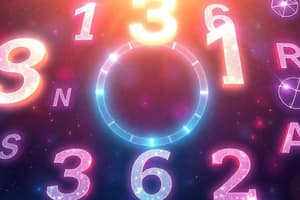Podcast
Questions and Answers
Which set consists of the first three natural numbers?
Which set consists of the first three natural numbers?
- {1, 2, 3} (correct)
- {-1, 0, 1}
- {1, 2, 3, 4}
- {0, 1, 2}
What does the concept of belonging in set theory imply?
What does the concept of belonging in set theory imply?
- An element is different from all members of a set.
- Sets can have overlapping elements.
- Only numbers can belong to sets.
- An element is part of a set. (correct)
Which of the following represents an improper subset?
Which of the following represents an improper subset?
- {} (correct)
- {1, 2}
- {2}
- {1, 2, 3}
What elements are included in the set of integers?
What elements are included in the set of integers?
Which of the following sets is correctly identified as a set of rational numbers?
Which of the following sets is correctly identified as a set of rational numbers?
What characteristic distinguishes the set E from the set of rational numbers Q?
What characteristic distinguishes the set E from the set of rational numbers Q?
Which equation represents the concept of correspondence between the set of red E and Q?
Which equation represents the concept of correspondence between the set of red E and Q?
Which of the following statements is true regarding the set R referenced in the content?
Which of the following statements is true regarding the set R referenced in the content?
What operation is being suggested for the red numbers as mentioned in the content?
What operation is being suggested for the red numbers as mentioned in the content?
What can be inferred about the smallest set of numbers in R?
What can be inferred about the smallest set of numbers in R?
Flashcards are hidden until you start studying
Study Notes
Sets and Numbers
- Sets: A collection of distinct objects, which are called elements. For example, the set containing the numbers 1/2 and 3 can be written as {1/2, 3}.
- Set Notation: Elements can be listed within curly braces
{}, with each element separated by commas. - Symbols used to describe elements: " ∈ " means "belongs to" and "∉" means "does not belong to."
- First set: 1/2 ∈ A and 3 ∈ A, but π ∉ A
- Second set: a ∈ B, b ∈ B, c ∈ B, d ∈ B, e ∈ B. j ∉ B
- Natural numbers: N = {1, 2, 3, ...} The set of all positive whole numbers (1, 2, 3, and so on).
- Integers: Z = {..., -3, -2, -1, 0, 1, 2, 3, ...} The set of all whole numbers, both positive and negative, including zero.
- Rational numbers: Q = {p/q | p, q ∈ Z, q≠ 0} The set of all numbers that can be expressed as a fraction of two integers.
- Real numbers: R = {all numbers that can be plotted on a number line} The set of all numbers that can be expressed as decimals, including rational numbers.
- Irrational numbers: I = {x ∈ R | x ∉ Q} The set of all numbers that cannot be expressed as a fraction of two integers (e.g., π, √2).
- Subsets: A set A is considered a subset of set B if all of the elements of A are also elements of B. A ⊆ B
- The set of real numbers includes: all rational numbers, all irrational numbers, and all whole numbers.
Studying That Suits You
Use AI to generate personalized quizzes and flashcards to suit your learning preferences.




